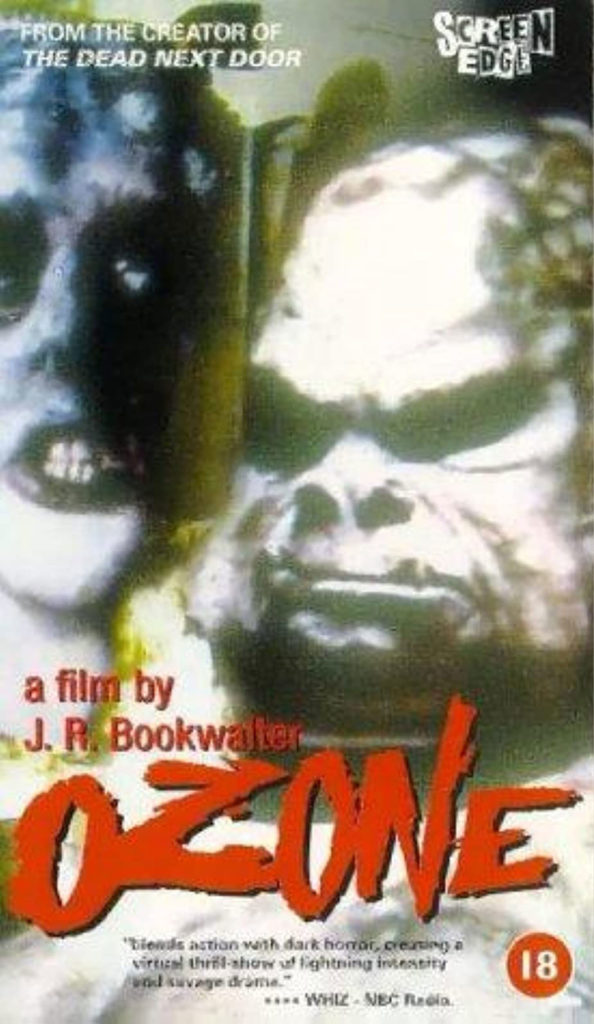By 1993, when Ozone was released, J.R. Bookwalter had already established himself as Akron, Ohio’s finest filmmaker. That’s not a knock on Jim Jarmusch, just an acknowledgment that Bookwalter actually shot his movies in Akron.
The filmmaker behind such trash horror classics as The Dead Next Door and Robot Ninja, Bookwalter began his movie career shooting on film, before making the switch to video for Kingdom of the Vampire in 1991. After a string of shorter movies, Ozone returned Bookwalter to full feature length production.
Ozone is a new drug that has hit the streets of the gritty city. Manufactured and distributed by the mysterious Sam DeBartolo (James L. Edwards), ozone is cooked and injected like heroin. Unlike heroin, it doesn’t transport users to a land of orgiastic bliss. Rather, it mutates them, turning them into flesh-dripping, murderous, loyal servants of DeBartolo, who has designs on world domination.
Cops Eddie Boone (James Black) and Mike Weitz (Tom Hoover) are on the case. After busting up a drug deal and pursuing the perps into an abandoned building, Boone and Weitz become separated. Weitz gets the worst of the deal, losing a hand and being captured by DeBartolo’s junkies, while Boone is injected with some ozone, allowing the bad guy he was corralling to get away.
Later, Boone begins to suffer horrendous dreams and hallucinations, picturing himself melting into oozing puddles, as ozone begins to mutate his body like the junkies, while he continues his search for his missing partner.
What follows are some standard cop flick clichés, including a pissed off captain (Jerry Camp), a suspension, and ignoring said suspension to carry on with the case. The movie is also something of a head trip as Boone struggles with the effects of the drug. He’s been  exposed to it just once, so he doesn’t go all gooey like the regular users, but he is struggling to keep from falling into their fold.
exposed to it just once, so he doesn’t go all gooey like the regular users, but he is struggling to keep from falling into their fold.
Bookwalter’s screenplay (besides writing and directing, he also shot and edited) is not the most coherent piece of storytelling, but that doesn’t seem to have been his intention. Boone is a character whose mind is under assault, and a linear story would not have served this movie as well. Ozone is no true mindfuck. Those are few and far between, as the degree of difficulty for a writer is high. For a movie with a budget of around $3,500, this story is pretty damned good.
As was Bookwalter’s ambition. Plenty of shot on video movies featured in this month’s Horrorshow have just been rank — amateurish in the extreme. Despite barely having two nickels to rub together, and the type of cast willing to work under such conditions, Bookwalter made a movie that moves.
There is also a wonderful amount of gore. Bookwalter and his effects team, including a couple folks who went on to long Hollywood careers, perfected the art of the bursting blood vessel, making it look as if some Bazooka bubblegum was blowing up under the skin. Then there is all the body horror, featuring Boone in screaming agony as his body changes, and some characters that were ripped straight from Hellraiser. My favorite scene with gore effects was more about the situation, rather than the head-splattering fun. In this scene, Boone has to fend off a fellow police officer in a parking lot, and said officer has to dodge multiple fast-moving vehicles before he is finally run down. Bookwalter filmed the scene like it took place on a major thoroughfare, when it’s clearly a parking lot. Sure, it’s all very cheap. But, again, thirty-five hundred bucks!
One chilling shot featured Boone, who is black, coming out of the bathroom of a bar, and the bar patrons, all white, are surrounding the door and staring at him in silence. Viewers get a POV shot, with all these extras staring death into the camera. It’s just one of many moments in the movie that will make a viewer go wide-eyed, despite the overall quality.
As a side note, much of Ozone was shot in disused buildings at the Edwin Shaw Hospital just across the southern border of Akron. A one-time tuberculosis sanatorium, the hospital closed in 2009 and the entire campus has since been razed, but not before I got in to take some photos 25 years after Bookwalter and company were there. One room, in fact, still featured some of the set dressing used in the movie, and I had no idea at the time.
Ozone is one of the most watchable movies for It Came from the Camcorder. Considering the competition, that isn’t saying much. It’s on the low end of the kind of fare that was being released direct-to-video in the 1990s. It has its qualities, though, not least the perseverance of a filmmaker whose budgetary expenditures across 17 directing credits on IMDb total less than half a million dollars. Even Oren Peli couldn’t do that. This nugget of underground cinema enters the Watchability Index at #305, displacing Double Exposure.
